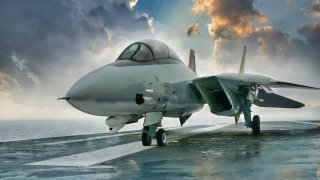The F-14 Tomcat Had a Shot at Hitting a Speed of Mach 2.5 (Or More)
The F-14 Tomcat, developed in response to the U.S. Navy's need for a long-range interceptor in the 1960s, was a technological marvel designed to counter the threat of Soviet bombers and missiles.
Summary: The F-14 Tomcat, developed in response to the U.S. Navy's need for a long-range interceptor in the 1960s, was a technological marvel designed to counter the threat of Soviet bombers and missiles.
-With a length of 62 feet and a maximum takeoff weight of 74,350 lbs, the Tomcat was one of the largest carrier-based fighters, capable of speeds exceeding Mach 2. It featured a unique swing-wing design, allowing for optimal performance at high speeds and improved handling at lower speeds for carrier landings.
-Armed with AIM-54 Phoenix, AIM-7 Sparrow, and AIM-9 Sidewinder missiles, along with a 20 mm Vulcan cannon, the F-14 excelled in air superiority roles. Stories from pilots like Doyle Borchers and Dave Andersen highlight the aircraft's capability to push beyond its operational limits, embodying a bygone era of high-speed jet aviation.
The F-14 Tomcat: Defining Naval Air Superiority in the Jet Age
The U.S. Navy in the 1950s recognized a problem with its aircraft carriers. Technological advances had made these warships vulnerable to long-range anti-ship missiles fired by Soviet aircraft and submarines well outside the traditional engagement range of its airwing.
Aware of the need for a new interceptor that could fly farther and deliver long-range munitions against enemy aircraft or missiles, the Navy began development in the early 1960s. The Navy impressed upon Congress the need for a completely new fighter in 1968, and this aircraft would become the F-14 Tomcat.
Introducing the Tomcat
At 62 feet, 9 inches long with a max takeoff weight of 74,350 lbs, the Tomcat was one of the largest carrier-based fighters ever designed. Capable of flying faster than Mach 2, it was designed to dash out from the carrier and intercept incoming enemy aircraft and cruise missiles using its AIM-54 Phoenix long-range and AIM-7 Sparrow medium-range missiles. It could also mount the AIM-9 Sidewinder, while a 20 mm Vulcan cannon cut its edge as an air superiority fighter.
The platform’s unique “swing-wing” geometry allowed the Tomcat to streamline its wings for high-speed performance or sweep them forward for improved low-speed characteristics, such as when landing on an aircraft carrier.
Other Specs & Capabilities: F-14 Tomcat and Mach 2.5
Designers knew the F-14 needed to be fast enough to intercept the Soviet Union’s supersonic Tu-22 bombers. As such, it was capable of flying at least Mach 2.0, although the Navy imposed a limit of 1.88 Indicated Mach as “the Mach meter [sic] got squirrely in that region,” according to former test pilot Doyle Borchers.
This did not stop pilots from pushing the limit. On one sortie, Borchers recalls, he checked the meteorology reports for his flight and concluded he could easily exceed Mach 2.0 true airspeed if he flew 1.72 indicated Mach. (The difference between indicated and true airspeed is a function of temperature and pressure.) And so, he did just that.
Upon landing however, “I was taxiing into the line, the plane captain seemed excited. I got out and post flighted the airplane. The whole rear end of the airplane was scorched. Got in to debrief and rechecked the air temp at 45K and metro had screwed up. At the temp that we actually flew at, we must have exceeded Mach 2 considerably since the epoxy paint on the airplane was designed to withstand temperatures up to 2.4M.”
Borchers wasn’t the only pilot to push the limits of his machine. A former Radar Intercept Officer, Dave Andersen, recounts one high-speed run he made in a Tomcat:
“In maybe fifty seconds we went from about four hundred knots and reached the advertised top speed of Mach 2.34, and the jet was still accelerating. I’m sure she would’ve gone past 2.5 Mach if we’d let her, but backed off at that point because we were getting close to ‘bingo’ fuel state.”
While modern jets such as the F-35 Lightning II certainly have serious advantages over the F-14, these stories recall a time of massive engines going full-burner and the exhilaration of pushing a marvelous aircraft to its limits.
About the Author: Maya Carlin
Maya Carlin, National Security Writer with The National Interest, is an analyst with the Center for Security Policy and a former Anna Sobol Levy Fellow at IDC Herzliya in Israel. She has by-lines in many publications, including The National Interest, Jerusalem Post, and Times of Israel. You can follow her on Twitter: @MayaCarlin.


